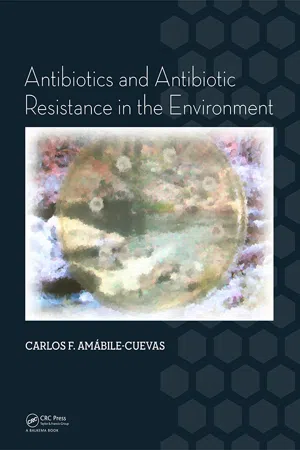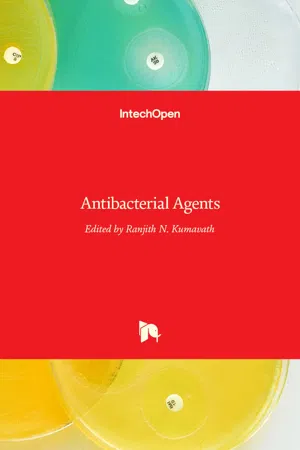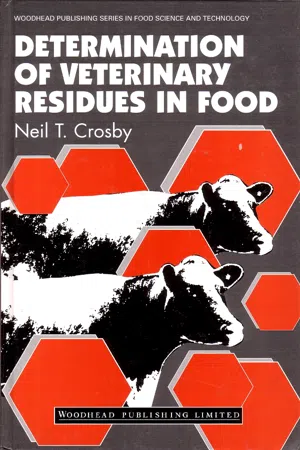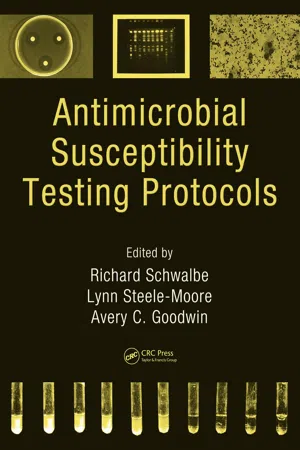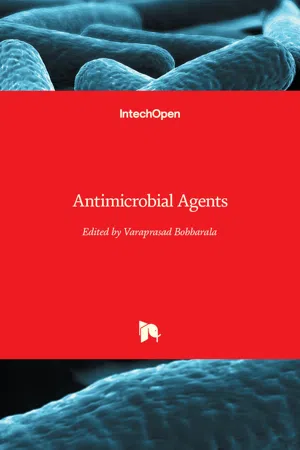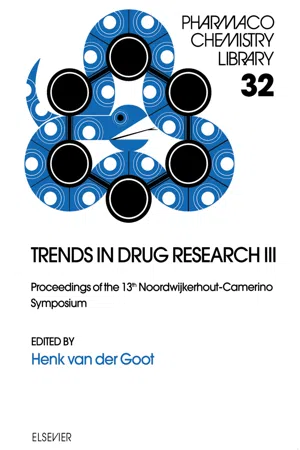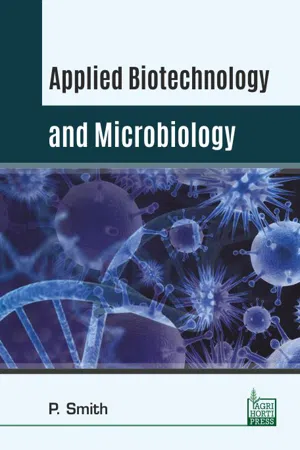Biological Sciences
Antibiotics
Antibiotics are a class of medications used to treat bacterial infections by either killing the bacteria or inhibiting their growth. They are produced naturally by microorganisms or synthesized in the laboratory. Antibiotics are a crucial tool in modern medicine for combating bacterial diseases and have significantly reduced the mortality and morbidity associated with such infections.
Written by Perlego with AI-assistance
Related key terms
1 of 5
10 Key excerpts on "Antibiotics"
- Carlos F. Amabile-Cuevas(Author)
- 2015(Publication Date)
- CRC Press(Publisher)
1.1 A NT I B I OT I C S : ORIGINS AND A CT IV ITY “Antibiotic’’, according to the Merriam-Webster dictionary, is “a substance produced by or a semisynthetic substance derived from a microorganism and able in dilute solu-tion to inhibit or kill another microorganism’’. This definition would encompass things like natural penicillin (a product of a mold) and ampicillin (a semisynthetic derivative of penicillin); exclude entirely synthetic agents such as sulfonamides and quinolones; and leave in a limbo drugs like chloramphenicol which, although initially discovered as a product of soil bacteria, it is now produced entirely by chemical synthesis. A wider definition from Wikipedia states that “Antibiotics [ . . . ] are a type of antimicrobial used in the treatment or prevention of bacterial infection’’, whereas “antimicrobial’’ is sim-ply “an agent that kills microorganisms or inhibits their growth’’, which would also 2 Antibiotics and Antibiotic Resistance in the Environment include antiseptics and disinfectants. Then there are “antibacterials’’, “anti-infective chemotherapy’’, and so on. For the purposes of this book, as there is no evident advan-tage in discriminating at every sentence between natural and synthetic compounds, an antibiotic would be a chemical agent with a selective toxicity profile, capable of killing or inhibiting the growth of bacteria but mostly incapable of exerting toxicity upon eukaryotic cells at the same concentration (the “magic bullet’’ imagined by Paul Ehrlich), that is commonly used to treat or prevent bacterial infections. This definition would therefore include all drugs, of natural or synthetic origin, used against bacte-ria; and would exclude compounds used against viruses, fungi, protozoans or other microorganisms, as well as non-selective biocides, such as disinfectants and antiseptics.- eBook - PDF
- Sati, S C(Authors)
- 2021(Publication Date)
- Daya Publishing House(Publisher)
Microorganisms are highly exploited in this regard. From time immortal man started utilizing microorganisms for various purposes (food processing, seasoning to wine production, etc). An easy handling and high growth rate made them one of the efficient tools in industrial microbiology. The age old experiences and experiments have made these microorganisms one of the inevitable tools of the day. They have proved their efficiency in various fields such as secondary metabolites, processing of metal ores and even in the production of various biopharmaceuticals, which improved the morbidity considerably like a wide range of Antibiotics to different hormones like insulin using genetic engineering. Currently, the complete genetic sequences of more than 580 microbes are known to date. It is possible to identify pathways that produce new compounds by analyzing the DNA sequences and many gene clusters likely to encode natural products. Nature has provided man with exquisitely potent and specific agents such as Antibiotics that have proved useful as drugs in the treatment of diseases and as tools in the study of biological processes. The discovery of Antibiotics greatly improved the quality of human life in the last century. The word antibiotic comes from anti-“against,” and bios, meaning “life.” Antibiotic drugs are made from living organisms such as fungi, molds, and certain soil bacteria that are harmful to disease-causing bacteria. Antibiotics can also be produced synthetically or combined with natural substances to form semi-synthetic Antibiotics. Antibiotics are drugs used to fight infections and infectious diseases caused by bacteria and other organisms. It is believed that Antibiotics accomplish these actions by damaging bacterial cell walls or by otherwise interfering with the function of the cells. Microorganisms have the ability to synthesize a wide range of complex chemicals ranging from bio-plastics to enzymes that are used in laundry detergents. - eBook - PDF
- Ranjith N. Kumavath(Author)
- 2017(Publication Date)
- IntechOpen(Publisher)
It is aimed that this approach will be equally helpful for researchers, clinicians, and academicians. 2. Classification Infectious diseases are the major causes of human sickness and death. To overcome such health care issues, Antibiotics proved to be promising agents ever since they were introduced in the 1940s. Antibacterials, which are a subclass of Antibiotics, have been classified earlier in several ways; however, to make it more easily understandable, we can classify antibacterial agents into five groups: type of action, source, spectrum of activity, chemical structure, and function [1 ]. 2.1. Classification based on type of action Generally, antibacterials can be classified on the basis of type of action: bacteriostatic and bactericidal. Antibacterials, which destroy bacteria by targeting the cell wall or cell membrane of the bacteria, are termed bactericidal and those that slow or inhibit the growth of bacteria are referred to as bacteriostatic. Actually, the inhibition phenomenon of bacteriostatic agents involves inhibition of protein synthesis or some bacterial metabolic pathways. As bacterio‐ static agents just prevent the growth of the pathogenic bacteria, sometimes it is difficult to mark a clear boundary between bacteriostatic and bactericidal, especially when high concen‐ trations of some bacteriostatic agents are used then they may work as bactericidal [2 ]. Some prominent examples of bacteriostatic and bactericidal antibacterials along with their mode of action are presented in Table 1 . Antibacterial Agents 2 2.2. Classification based on source of antibacterial agents Antibacterials are the subclass of Antibiotics, which can be naturally obtained from fungal sources, semi‐synthetic members which are chemically altered natural product and or syn‐ thetic. Cephalosporins, cefamycins, benzylpenicillin, and gentamicin are well‐known exam‐ ples of natural Antibiotics/antibacterials. - eBook - PDF
Antimicrobials
Synthetic and Natural Compounds
- Dharumadurai Dhanasekaran, Nooruddin Thajuddin, A. Panneerselvam, Dharumadurai Dhanasekaran, Nooruddin Thajuddin, A. Panneerselvam(Authors)
- 2015(Publication Date)
- CRC Press(Publisher)
155 chapter nine Bacteriocin A natural alternative to synthetic antibacterial Antibiotics S. Latha and Dharumadurai Dhanasekaran 9.1 Introduction Antimicrobials are unarguably one of the most important medical discoveries of the twentieth century and function as a vital medicine for the treatment of bacterial infec-tions in both humans and animals. Moreover, they have played a major role in the growth and development of food-producing animals (poultry, goat, sheep, beef, and dairy cattle) mainly by improving their efficiency in growth rate, feed utilization, mortality reduction, etc. However, the continuous use of Antibiotics led to the emergence of microbial resis-tance, dissemination of resistant bacteria, and resistance genes to pathogenic bacteria in both humans and animals. A major issue is that antimicrobial resistance (AMR) not only occurs among disease-causing organisms but has also become an issue for other resident organisms in the host. In addition, consumers are also becoming increasingly concerned about the accumulation of drug residues in meat products of food animals (Thacker, 2013). Contents 9.1 Introduction ........................................................................................................................ 155 9.2 Bacteriocins: A class of antimicrobial peptides ............................................................. 156 9.3 Bacteriocins versus conventional Antibiotics ................................................................. 157 9.4 Classification of bacteriocins ............................................................................................ 158 9.4.1 Bacteriocins from gram-negative bacteria ......................................................... 158 9.4.2 Bacteriocins from gram-positive bacteria .......................................................... 161 9.4.2.1 Lactic acid bacterial bacteriocin ............................................................ - eBook - PDF
- N T Crosby(Author)
- 1991(Publication Date)
- Woodhead Publishing(Publisher)
4 Antibiotics 4.1 DEFINITION AND SCOPE The word antibiotic is derived from the Greek words anti, meaning against, and bios meaning life. Paradoxically, Antibiotics are now used most widely to protect human and animal life, but at the expense of lower orders in the animal kingdom. However, other groups of chemical agents are known which are also active against micro-organisms in general, or more specifically against particular species of bacteria, fungi or viruses. Thus, antiseptics are compounds used in the treatment of human or animal tissues (usually the skin) to kill or inactivate pathogenic micro-organisms. Examples of this group include acriflavine, chlorhexidine, iodine, quaternary ammo-nium compounds, heavy metals and salicylic acid. Disinfectants are similarly active against a range of common disease-producing micro-organisms and are usually bactericidal rather than bacteriostatic, and are applied to surfaces and equipment but not normally ingested. Whilst they do not kill all micro-organisms (especially bacterial spores) they generally reduce the level of contamination to an acceptable level (British Standards Institution, 1986). Some disinfectants are non-toxic to humans and animals, and can then be used as antiseptics. Nevertheless, most antiseptics and disinfectants are too toxic for internal, systemic use in human or animal medicine and the active ingredient is used at a much higher concentration than is the case with Antibiotics. Hence antiseptics and disinfectants are not incorporated into animal feeding stuffs or used in veterinary medicine on a conti-nuous basis and so are unlikely to find their way into the food chain. However, some concern has been expressed over the use of iodo-compounds as antimastitis teat dips for cows and for the disinfection of equipment used in the dairy industry, possibly leading to high levels of iodine in the diet and problems with hyperthyroidism. - Richard Schwalbe, Lynn Steele-Moore, Avery C. Goodwin(Authors)
- 2007(Publication Date)
- CRC Press(Publisher)
It wasn’t until his 606th experimental compound that he discovered a medically useful drug. This compound, later named salvarsan , was arsenic based, and the fi rst treatment for syphilis [1]. In 1889, Vuillemin, a French bacteriologist, suggested using the word antiobiosis , meaning “against life,” to describe the group of drugs that had action against microorganisms [2]. Selman Waksman, an American microbiologist and the discoverer of streptomycin, later changed this term to antibiotic [3]. Many Antibiotics have been discovered since then (Table 2.1), but the discovery of penicillin may be one of the most important events in the practice of infectious disease medicine. To date, the U.S. Food and Drug Administration (FDA) has approved 18 Antibiotics derived from penicillin and 25 classi fi ed as cephalosporins [4,5]. Traditionally, antimicrobial agents have been classi fi ed based on their mechanism of action, chemical structure, or spectrum of activity. The primary mode of action is the inhibition of vital steps in the growth or function of the microorganism. These steps include inhibiting bacterial or fungal cell wall synthesis, inhibiting protein synthesis, inhibiting nucleic acid synthesis, or disrupt-ing cell membrane function (Table 2.2) [6]. Antibiotics are often described as “bacteriostatic” or “bactericidal” (Table 2.2). The term bacteriostatic describes a drug that temporarily inhibits the growth of the organism. Once the drug is removed, the organism will resume growth. The term bactericidal describes a drug that causes cell death. For infections that cannot be eradicated by host mechanisms (e.g., endocarditis) or for patients who are immunocompromised (e.g., Acquired Immunode fi ciency Syndrome), a bactericidal drug is often required [7]. 2.2 Antibiotics 2.2.1 P ENICILLINS 2.2.1.1 Background Penicillin was fi rst discovered in 1928 by a young Scottish bacteriologist, Alexander Fleming, while studying staphylococcal bacteria at St.- eBook - PDF
- Preethi Kartan(Author)
- 2019(Publication Date)
- Delve Publishing(Publisher)
The chapter below outlines all those micro-organisms that act as the building blocks of biotechnology and would be required for producing Antibiotics. 5.1 INTRODUCTION Natural product compounds (NPCs), particularly obtained from micro-or-ganisms (like bacteria and lower eukaryotes) are important resources for many medicines. Drugs derived from such microbial origin have been cat-egorized into three types of products: • original microbial products, • products derived or chemically processed from microbial products, • synthetic products based on microbial product structures. Initial scientific researches in the field of soil microflora (the intimate part of soil organic matter, consisting of live and dead microbial cells) made scientists wonder on the presence of some compound that held the key to their survival. The soil, regardless of joining with billions of microorganisms, enables only some of them to endure the struggle for existence. Recently, many chemical compounds utilized in the treatment and management of cancer, infections due to drug-resistant microbes (bacteria, fungi, and viruses), and immunosuppressive disorders, are extracted from microbial sources. Researches and experiments led to the concept of ‘‘antibiosis’’. The term antibiosis means ‘against life’. The famous Nobel Prize winner, Selman Abraham Waksman, invented the term ‘‘antibiotic’’. Introduction of microbial antibiotic as like penicillin and streptomycin confirmed the affirmation that microorganisms should be experimented upon more for new and unique bioactive compounds for the treatment of terminal diseases. The pharmaceutical industry is deeply influenced by the development of antibacterial drugs, and as a result, the market is filled with old drug scaffolds. Basically, the scaffold of a molecule is taken to be its framework, defined as all its ring systems and all linkers that connect them. - eBook - PDF
- Varaprasad Bobbarala(Author)
- 2012(Publication Date)
- IntechOpen(Publisher)
2 Future Antibiotic Agents: Turning to Nature for Inspiration Nataša Radi ć 1,2 and Tomaž Bratkovič 1 1 Department of Pharmaceutical Biology, Faculty of Pharmacy, University of Ljubljana, Ljubljana 2 AB Inovacije d.o.o., Mirna Slovenia 1. Introduction Few drugs have made such a profound impact on modern medicine as Antibiotics. With the discovery of sulfonamides, β-lactams, and subsequent antibiotic classes after World War II, bacterial infections with often fatal outcomes literally became curable overnight. These “magic bullets,” however, suffer from a serious drawback; the use (and misuse) of Antibiotics induces selection pressure resulting in the development of resistance traits in bacterial populations. The process is augmented by short generation times of bacteria enabling rapid mutation and selection of resistant strains, and a horizontal transfer of resistance genes. Bacterial pathogens resistant to more than one, or even most clinically used Antibiotics, have become common (Fischbach & Walsh, 2009). Faced with the fact that a renewed pre-antibiotic era might be just around the corner, the World Health Day 2011 campaign “Antimicrobial resistance and its global spread” launched by the WHO offers a strategy to safeguard existing Antibiotics for future generations, and contain the spread of antimicrobial resistance (World Health Organization, 2011). However, taking a more sensible approach in prescribing and using available antibiotic drugs will only help to put off the inevitable. In the battle against the ever-increasing multidrug resistance of pathogenic bacteria, we urgently need new alternatives to the currently available broad-spectrum Antibiotics. Here we review some current trends in antibiotic discovery focusing on the screening of natural products. - eBook - PDF
- H. van der Goot(Author)
- 2002(Publication Date)
- Elsevier Science(Publisher)
H. van der Goot (Editor) Trends in Drug Research III © 2002 Elsevier Science B.V. All rights reserved 193 Antibacterials as Wonder Drugs and How Their Effectiveness Is Being Compromised Dasantila Golemi,§ Laurent Maveyraud,* Jalal Haddad, Wenlin Lee, Akihiro Ishiwata,§ Kazuyuki Miyashita,§ Lionel Mourey,+ Sergei Vakulenko, Lakshmi Kotra, Jean-Pierre Samama,-!- and Shahriar Mobashery,§* •••Groupe de Cristallographie Biologique, Institut de Pharmacologic ct de Biologic Structurale du CNRS, 205 route dc Narbonnc, 31077-Toulousc ccdcx, France ^Department of Chemistry and Institute for Drug Design, Wayne State University, Detroit, MI 48202-3489 USA. Treatment of infections by bacterial pathogens became possible only in the twentieth century. Indeed, virtually all classes of antibacterials that are in clinical use presently were discovered and developed in the span of a mere 30 or so years. The advent of Antibiotics, along with immunization, has had profound consequences on the quality of life. Life expectancy increased in the United States by 30 years from the beginning to the end of the twentieth century, as a direct consequence of these developments [1]. These successes created an air of complacency. There was the perception that bacterial infections were infinitely curable. This view was strengthened by the late 1960s into 1970s, in part because of the discoveries of the various classes of Antibiotics, but also by the fact that medicinal chemists appeared to be able to improve these molecules of natural origins by synthetically altering them. These synthetic molecules were often more potent that their parental natural products, and at times the breadth of activities were also increased to create pharmaceuticals that were being hailed as miraculous in the clinic. The euphoria lead to complacency, such that by the late 1980s and earlier 1990 many pharmaceutical companies decided to leave the field of Antibiotics. - eBook - PDF
- Smith, P(Authors)
- 2018(Publication Date)
- Agri Horti Press(Publisher)
Toxins, gibberellins, alkaloids and Antibiotics are examples of secondary metabolites or idiolites. Secondary metabolites are produced by a limited number of microorganisms, when there is depletion of one or more nutrients in the culture medium. Antibiotics Antibiotics are metabolites having preferential antimicrobial activity. The phenomenon of growth inhibition by Antibiotics is known as ‘antibiosis’. Antibiotics are defined as ‘the complex chemical substances, which are produced by microorganisms as secondary metabolites and act against other microorganisms.’ Antibiotics have now found wide application in chemotherapy, plant pathology, food preservation, veterinary medicine and are used as research tools in biochemistry and molecular biology. About 7000 Antibiotics are This ebook is exclusively for this university only. Cannot be resold/distributed. 15 Introduction known today and hundreds of these are produced commercially by microbial fermentation. Penicillin is used to produce semi-synthetic penicillin - 6 APA (Ampicillin, amoxycillin and cloxacillin) and 7ACDA (cephaloxin). The use of 6APA and 7ACDA has increased due to their lower side effects; they are manufactured from Penicillin G. HAL = Hindustan Antibiotics Ltd., Pune, IDPL = India Drugs and Pharmaceuticals Ltd., Rishikesh. Table. Antibiotics Produced by Microorganisms Microorganism Antibiotics Applications Bacteria Bacillus brevis Tyrothricin (G+, G-) Mouth and throat infection B. polymyxa Polymyxin B (AT) UTI, gastroenteritis B. subtilis Bacitracin (G+) Dematitis, superfical pyogenic infection, dtsentery Streptocous cremotis Nisin (G+) In cheese, food preservation (non-medical use) Actionomycetes Micromonospora purpurea Gentamycin (G+, G-) UTI, abscess Nocardia mediterranei Rifamycin (My) Meningitis Streptomyces griseus Streptomycin (G+, G-, My) Tuberculosis S. aureofaciens Tetracyclines* (G+, G-) Cholera, tetanus, UTI S. erytbreusa Erythromycin (G+) Choilera, tetanus, arthritis S.
Index pages curate the most relevant extracts from our library of academic textbooks. They’ve been created using an in-house natural language model (NLM), each adding context and meaning to key research topics.
